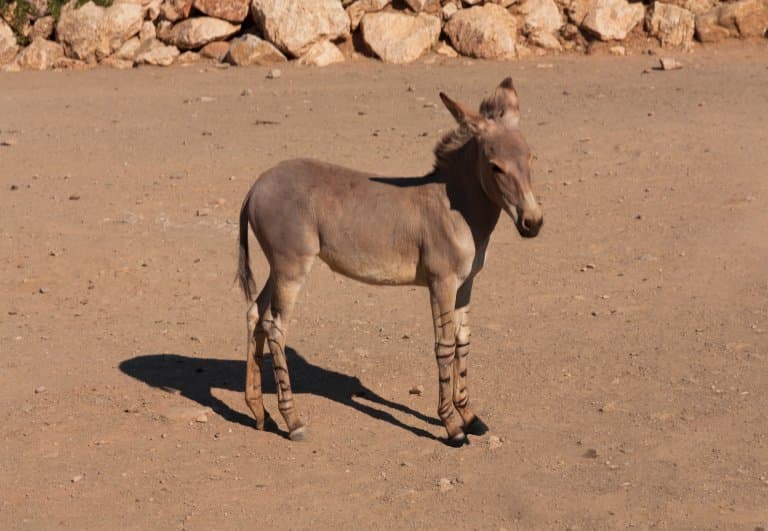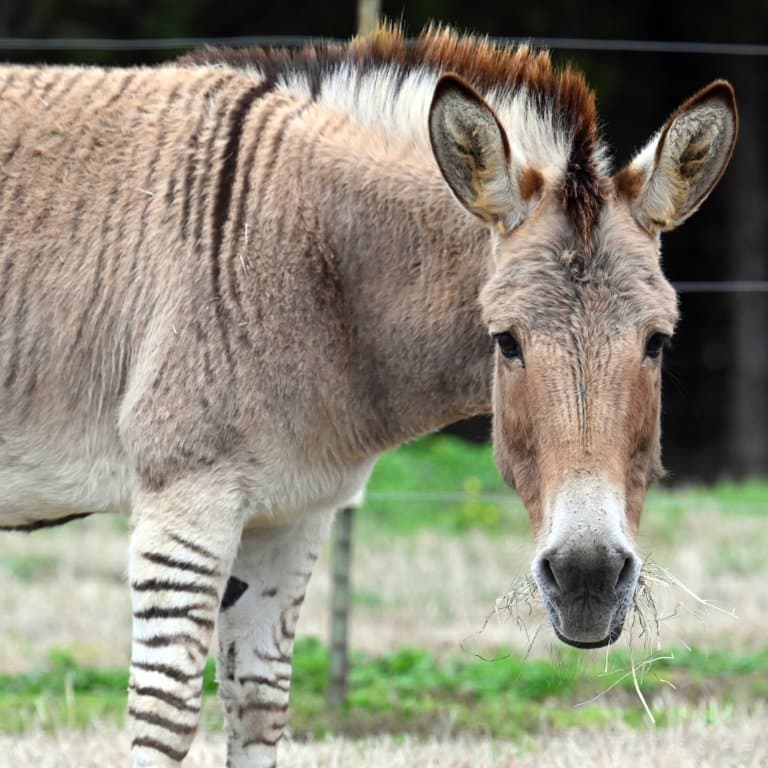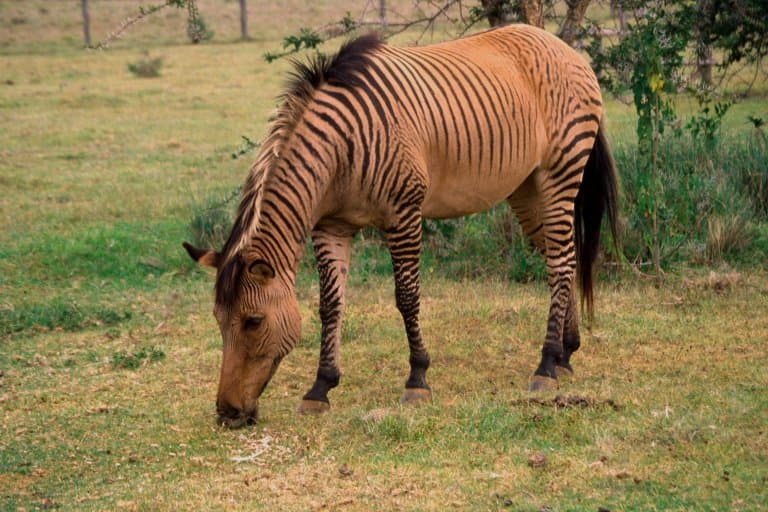Zonkey Profile
In the sport of unimaginative hybrid names, there’s a lot of competition.
Perhaps one of the most diverse sets of colloquialisms is given to any number of Equus hybrids, and among those, a zebra/donkey cross; a divisive product of deliberate pairings that often results in a sickly, striped donkey.
A zonkey is a hybrid offspring of a male zebra and a female donkey, but they have a variety of names including zebrass, or zedonk. They typically resemble a donkey, but with zebra like stripes.

Zonkey Facts Overview
| Habitat: | Captivity |
| Location: | Worldwide |
| Lifespan: | Around 20 years |
| Size: | Up to 1.5m (5ft) tall, 1.8m (6ft) long |
| Weight: | Up to around 300kg/700lb |
| Colour: | Usually brown or tan with black striped underbellies |
| Diet: | Herbivorous browsers: grasses, herbs, fruits |
| Predators: | None |
| Top Speed: | Not recorded |
| No. of Species: | 1 (hybrid) |
| Conservation Status: | Not Listed |
Zonkeys are an appealing curiosity in zoos over the world, and while gawkers are the major driver of funding for responsible captive animal research institutions, their very existence is criticised as unethical marketing by a large proportion of animal and zoo advocates.
Despite their cuteness, rarity and uniqueness both visually and genetically, these sorts of hybrids are commonly unhealthy and difficult to care for.
As such, questions of whether the significance of public spectacle justifies their somewhat tortured existence abound.
Interesting Zonkey Facts
1. They’re Zebroids
Hybrids are usually named casually with a mix of the male and female sire names, respectively. A zonkey, therefore would be the unholy product of a male zebra and a female donkey.
But there’s not a good name for a donkey/zebra hybrid, and this is strange since there are hundreds of bad ones. The general term is Zebroid, referring to any mix between zebras and other Equids, including horses, mules, asses, and so on.
A cross between a zebra and a donkey, while it’s often called Zonkey, can also be referred to as a Zebrass, Zedonk, Zebret, Zebrinny, Zebronkey, and plenty more names.
If it’s born to a female zebra, the offspring might be called a Donkra.
This range of bizarre names reflects the lack of seriousness in the practice and is something of a source of controversy among breeders and zoologists. Zebroids don’t occur typically in the wild, though some are found in South Africa, where the two habitats overlap artificially.
The majority of them are sterile, so wouldn’t be able to pass on their genes, and there’s not much effort to distinguish between zebra species involved in the mix.

2. They come in a variety of colours
The cross-breeding of the two species involved creates a bit of a lucky dip of genetic expressions, and the resulting offspring usually have a unique mix of both donkey and zebra characteristics.
The physical form usually most closely resembles the donkey parent, but they will usually inherit at least some of the zebra stripes. Sometimes these cover the whole body, other times only the head or rump is striped.
Zonkeys usually have the fur colour of their donkey parent with the zebra stripes occupying their lighter underbellies.
3. They’ve been at it for centuries
Despite their flimsy existence, this cross-breeding has occurred for a long time. It appears that even ancient peoples had a bit of a sense of humour about this quirky combination.
Perhaps as a result of the Zebra’s notorious resistance to domestication, there is archaeological evidence of equid hybrids dating back centuries. Whether these hybrids involved zebras or other members of the Equine family is a matter of study, and one group has paid tribute to the Zonkey by naming their genetic investigation after them.
‘Zonnkey’ is now the name of an advanced form of DNA sequencing recipe, aimed at figuring out from archaeological remains what our ancestors were up to when crossing various horse or donkey species with one another.
Zebras are known to be resilient against diseases like those passed on by the Tsetse fly, so early hybrids may have been intended to produce carrying animals that are both domesticated and resistant to disease.
While it’s likely these hybrids were mostly chosen for their advantages over the original species, most of the time, modern zebra hybrids aren’t all that healthy. 1
4. They usually have mismatched chromosomes
Despite being members of the same genus, donkeys, horses, mules, zebras, and other familiar equids have a varying number of chromosomes, usually different from one another.
Even the three species of zebra don’t share chromosomal pairs, and domestic donkeys have almost twice as many as Mountain zebras.
This incompatibility is surprisingly narrow enough for the two sires to create healthy offspring (though, not always), but it will almost always prevent these offspring from being able to breed. A zonkey crossed between a Plains zebra with 44 chromosomes and a donkey with 62 chromosomes has a unique set of 53 of its own.
Perhaps more importantly, this can cause significant health issues. 2 3

5. They’re often dwarves
Zonkeys are typically bred for superficial appeal, and the health of the resulting animal isn’t of much concern.
They’re almost exclusively found in zoos and private collections, and not only are they almost always infertile, they’re also often quite unwell.
Other infamous examples of sick hybridisation are the ligers and tigons, who also suffer from a range of genetic defects as a result of their loose combinations of DNA.
Zonkeys have higher rates of dwarfism, and likely suffer from other abnormalities and high juvenile mortality rates, too. But information regarding their longevity and long-term health is lacking.
Despite these health issues, Zonkey births are commonly celebrated in the media.
6. “Very rare and special”
The rarity of Zonkeys should not be an indicator of their importance. Yet, these hybrids often make the papers when they appear in zoos over the world.
Sometimes it’s by accident, like Ippo, the Zonkey that emerged from a zoo in Florence, sometimes it’s more deliberate, as was the case in Mexico with Khumba, and in a zoo in Crimea. In all cases, however, this breeding draws criticism from the zoological community.
Anna Kachurovskaya, from Moscow Zoo, strongly condemned the breeding as a form of marketing schemes that “don’t happen in civilised zoos”.

7. Not to be confused with painted donkeys
A far easier, and debatably more ethical way of procuring a Zonkey is to take a garden-variety donkey and a bucket of paint and get to work.
This is what happens in Tijuana, where the practice has become a bit of a tradition, and it seems to stem from the limitations of black-and-white photography. Since the ‘60s, white donkeys, commonly a tourist attraction were struggling to show up in photographs, leaving the American visitors disappointed with their souvenirs.
Locals apparently came up with the idea of painting stripes onto the animals, both increasing their novelty and making them more photogenic, without having to dabble with their genetics.
These donkeys with makeup are known locally as Zonkeys but are not the same thing as the Zebra-donkey hybrid.
8. There’s a ‘Zorse’, too!
You guessed it, this a hybrid between a zebra and horse known as a zorse.
The most important thing to know about zorses is that they are the hybrid offspring of horses and zebras. They are typically the result of a male zebra and a female horses, but this isn’t always the case.
Sometimes, it can be a female zebra and a male horse, and these are known as ‘Hebra’.

Zonkey Fact-File Summary
Scientific Classification
| Kingdom: | Animalia |
| Phylum: | Chordata |
| Class: | Mammalia |
| Order: | Perissodactyla |
| Family: | Equinae |
| Tribe: | Equini |
| Genus: | Equus |
| Species: | E. “zebra” × E. “equine” |
Fact Sources & References
- Mikkel Schuber (2017), “Zonkey: A simple, accurate and sensitive pipeline to genetically identify equine F1-hybrids in archaeological assemblages”, Science Direct.
- Gabe Buckley (2020), “Article Name”, Biology Dictionary.
- JASON BITTEL (2015), “Hold Your Zorses-The sad truth about animal hybrids”, Slate.
